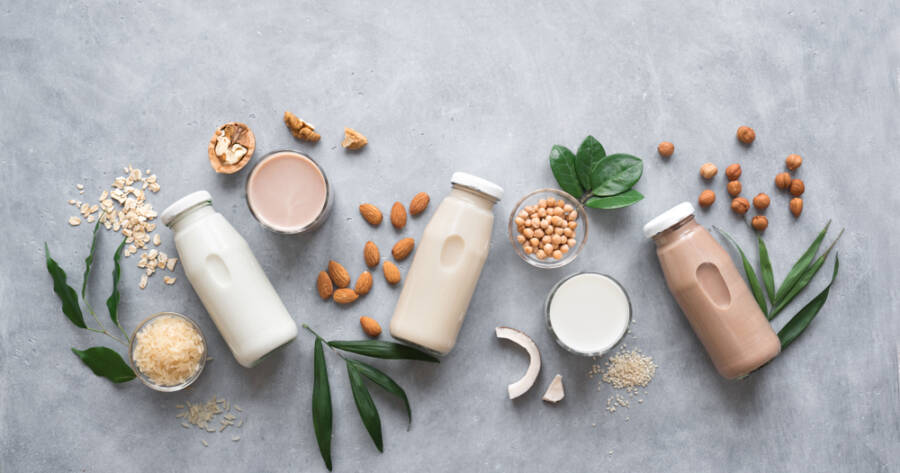Whether you’re lactose intolerant, vegan, or just trying to cut back on dairy, non-dairy milk alternatives have become a staple in grocery aisles and coffee shops alike. But with so many options—from almond to oat to soy and beyond—how do you know which one to choose?
The right non-dairy milk depends on what you’re using it for (smoothies? coffee? baking?), your dietary preferences, and of course, your taste buds. Here’s a breakdown of the most popular plant-based milks, including their flavor, texture, nutritional profile, and best uses.
Almond Milk: Light and Versatile
Flavor: Mild, slightly nutty
Texture: Thin and watery (unless labeled “barista blend”)
Nutrition: Low in calories (about 30–60 per cup), low in protein, usually fortified with calcium and vitamin D
Almond milk is one of the most popular plant-based options, known for its light, neutral flavor that blends well in many recipes. It’s great in smoothies, cereal, and baking. However, it’s not ideal for frothing in coffee unless you use a “barista” version specifically formulated to handle heat and steam without separating.
Best for: Light smoothies, oatmeal, baking, or as a general milk substitute in recipes.
Oat Milk: Creamy and Naturally Sweet
Flavor: Mild, slightly sweet, with a hint of oat
Texture: Creamy and smooth
Nutrition: Moderate calories (100–130 per cup), more carbs than other options, moderate protein and fiber
Oat milk has become a coffee shop favorite thanks to its rich texture and natural sweetness. It steams and froths beautifully, making it perfect for lattes and cappuccinos. It also works well in baked goods and creamy sauces.
Best for: Coffee drinks, baking, soups, and dairy-free cream sauces.
Soy Milk: High-Protein Classic
Flavor: Slightly beany with a creamy finish (flavored versions are more neutral)
Texture: Thick and smooth
Nutrition: Higher in protein (7–9 grams per cup), similar to cow’s milk in nutrition when fortified
Soy milk is one of the most nutritionally balanced milk alternatives, often favored by those looking for a higher-protein option. It’s great for cooking, baking, and frothing. Unsweetened varieties can taste a bit earthy, but flavored versions are more palatable for those new to soy.
Best for: Protein-rich smoothies, creamy soups, and cooking or baking where structure is important.
Coconut Milk (Carton, Not Canned): Light and Tropical
Flavor: Distinct coconut flavor, slightly sweet
Texture: Thin to medium, depending on the brand
Nutrition: Low in carbs and protein, moderate fat, around 45 calories per cup
Coconut milk in a carton is not to be confused with the rich, canned version used in curries. The drinkable kind is light, with a tropical flavor that works well in desserts, smoothies, and tropical-style breakfasts. It’s not ideal in savory dishes unless you want a noticeable coconut taste.
Best for: Smoothies, chia pudding, and recipes with tropical or sweet flavors.
Cashew Milk: Creamy and Neutral
Flavor: Mild and slightly nutty
Texture: Creamy but not too thick
Nutrition: Low in calories, low in protein, usually fortified with vitamins and minerals
Cashew milk offers a more neutral taste than almond or coconut milk and a creamier texture than almond milk. It blends beautifully into sauces and soups, and works well in creamy desserts or dairy-free mashed potatoes.
Best for: Creamy soups, sauces, and dishes where you want smooth texture without strong flavor.
Rice Milk: Light and Naturally Sweet
Flavor: Mildly sweet and neutral
Texture: Thin and watery
Nutrition: High in carbs, low in protein, around 120 calories per cup
Rice milk is the most hypoallergenic option, making it a good choice for people with nut, soy, or gluten sensitivities. It’s naturally sweet but very thin, which limits its usefulness in coffee or creamy recipes.
Best for: Drinking on its own, cereal, or recipes where other options are off-limits due to allergies.
Hemp Milk: Earthy and Omega-Rich
Flavor: Earthy, slightly nutty, sometimes grassy
Texture: Creamy, though can be gritty in some brands
Nutrition: Moderate protein (3–5 grams per cup), rich in omega-3 and omega-6 fats
Hemp milk is a nutritional powerhouse with healthy fats and decent protein, though its earthy taste may not be for everyone. It works best in smoothies or savory dishes that can handle its stronger flavor.
Best for: Smoothies, savory baking, or as a nutrient-dense milk option.
Picking the Right Milk for the Right Moment
With so many choices, there’s no one-size-fits-all when it comes to non-dairy milk. Your best bet? Try a few different types to see what suits your taste and needs.
Here’s a quick cheat sheet:
| Use | Best Non-Dairy Milk |
|---|---|
| Coffee & Lattes | Oat milk (barista blend), Soy milk |
| Smoothies | Almond, Oat, Hemp |
| Cereal | Almond, Rice, Oat |
| Baking | Almond, Soy, Oat |
| Sauces & Soups | Cashew, Soy, Oat |
| High Protein | Soy, Hemp |
| Allergy-Friendly | Rice, Oat (gluten-free certified), Coconut |
Sip Smarter
Choosing a plant-based milk is about more than avoiding dairy—it’s about finding what fits your lifestyle, taste preferences, and nutrition goals. Whether you want something rich and frothy for your coffee or a light option for smoothies, there’s a non-dairy milk that can do the job deliciously. With a little experimenting, you’ll find your favorites—and maybe even enjoy the switch more than you expected.

